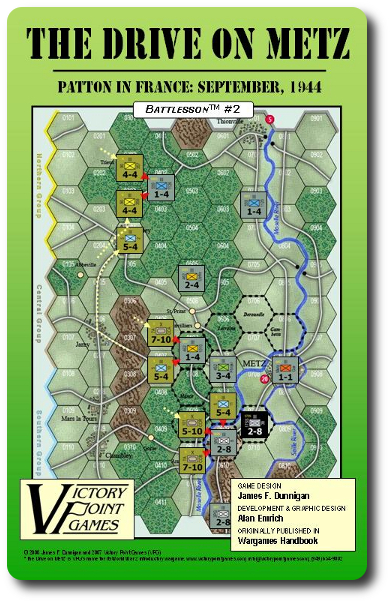
The Basics:
- For ages 8 and up (publisher suggests 12+)
- For 2 players
- Approximately 40 minutes to complete
Geek Skills:
- Counting & Math
- Logical & Critical Decision Making
- Reading
- Strategy & Tactics
- Risk vs. Reward
- Area Control
Learning Curve:
- Child – Moderate
- Adult – Easy
Theme & Narrative:
- It’s September 7th, 1944 and two forces are about to engage in a struggle that historically could have gone either way.
Endorsements:
- Gamer Geek approved!
- Parent Geek mixed!
- Child Geek approved!
Overview
It’s the morning of September 7th, 1944. If he can, Patton will take control of the city of Metz and cross the Moselle river. If they can do it fast enough, the United States can stop the retreating German forces from rallying. Historically, the Germans won, but the battle could have gone either way. If the United States had won, World Ward II could have ended months early, saving a countless number of lives on all sides.
The Drive on Metz, by Victory Point Games and part of their Battlesson series, is comprised of 1 foldout game map and 40 square chits that represent the United States and German forces, as well as other various markers and counters. Not included in the game, but necessary to play, is a standard six-sided die.
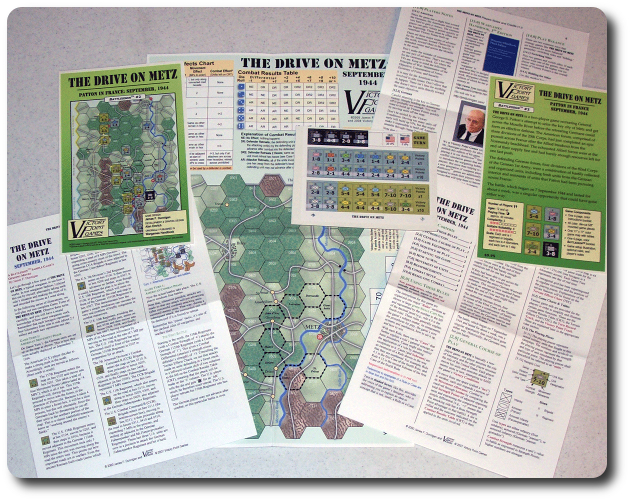
Game Set Up
To set up the game, first place the foldout game map between the two players. Note that the game map contains not only the area in which the players will do battle, but it also contains helpful reference tables, turn order sequence, a Victory Point track, a combat results table, and a Game Turn track.
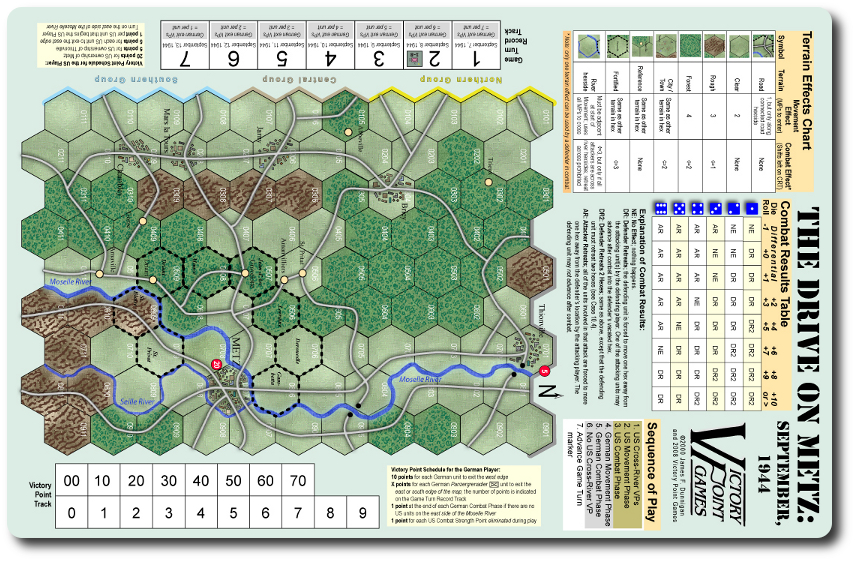
Second, determine who will play as the German forces and who will play as the United States forces. Note that the game is slightly biased towards the German forces (which is historically correct). New players to the game should take the German side for an easier game play experience.
Third, give to each player their initial unites. For this set up, all units with a victory point (VP) value in their upper right should be set aside. These are used in different game variants and scenarios, but not the base game summarized here. Note that the markings represent different unit types (infantry, armored, etc.), but play no real role in the game other than to help keep units organized and further reinforce the narrative.
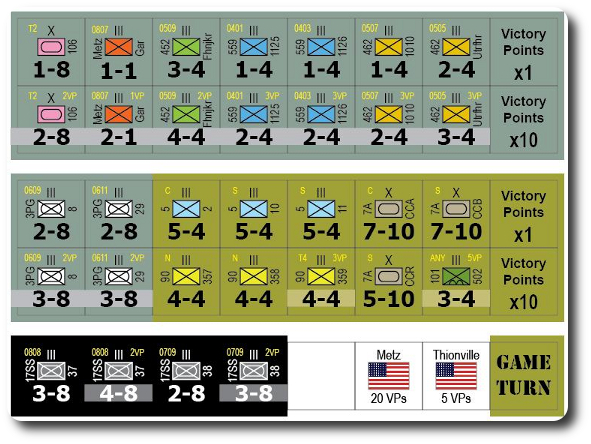
Each player now sets up their units on the map. Each unit has a starting position which are clearly described in the game rules and accompanying game visual aids.
Fourth, place the Game Turn marker in the box with the value “1” to indicate the first turn.
Fifth, place each player’s Victory Point markers in the matching boxes alongside the Victory Point track on the game map.
That’s it for game set up. Time to see if history repeats itself.
A River, a City, and a Chance
The game is a reenactment of Pattons’ forces attempting to take over the city of Metz in France and route the German forces before they can regroup and organize. The battle was hard-fought on both sides, with many casualties. Historically, the battle was won by the German forces, but nothing is for certain in this game. While the set up and balance is slightly tilted in the player’s favor who is playing the German forces, the game must still be won by both players through smart plays and logical thinking.
The game is played in 7 turns (each round is considered a day) with each turn consisting of 7 sequential steps. These steps are summarized here. To read the complete rules and get the full details, download the rules from the game’s web page.
Step 1: United States Victory Point Scoring
The first step determines if the player who is commanding the United States forces is awarded any victory points (VP). For every unit that is east of the Moselle river (north is indicated on the game map), the player is awarded 1 victory point.
Step 2: United States Unit Movement
The second step allows the commander of the United States forces to advance upon the city of Metz. The player can move as many or as few of their units as they like. Each unit has a movement allowance which provides a number of movement points that determines how many hexagon spaces they can traverse. As long as the unit has movement points to spend, it can be moved on the game map. A unit can never move through an enemy unit or end their turn on an enemy or friendly unit. A unit must stop if it passes in any of the 6 adjacent hexagonal spaces that surround an enemy unit, becoming immediately engaged. The game map contains all other information regarding terrain movement modifiers and combat modifiers based on the terrain found in the area.
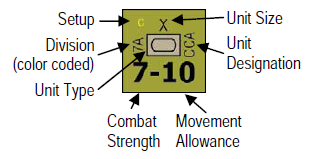
Step 3: United States Unit Combat
The third step allows the commander of the United States forces to engage in combat any enemy unit that is adjacent to theirs. Attacks can be done in an order, but each unit can only attack once and be attacked once, regardless of how many other enemy units surround it. These are referred to as “battles”. Units that are adjacent to a single enemy unit can, however, combine their attack strength to attack a single enemy unit during a battle. Each unit has a combat strength value that signifies the unit’s general ability to attack and defend. Note that combat is never required and is an optional step.
Combat is resolved by each player totaling up their units’ combat strength that are involved in the battle. The defender’s total combat strength is subtracted from the attacker’s total combat strength. The resulting number is referred to as the “combat differential”. The players then find this number on one of the columns found in the combat results table, consults the terrain table for any effects, and determine the final column value by shifting left and right of the initial combat differential value. The attacker then rolls the six-sided die and cross-indexes the rolled value with the final column value. The results will determine if combat is a stalemate, the attacker retreats, or the defender retreats.
Step 4: German Units Move
In this phase, the player commanding the German forces can now move as many or as few of their units as they like using the same rules as their opponent.
Step 5: German Unit Combat
In this phase, the player commanding the German forces can now attack enemy units using the same rules as their opponent.
Step 6: German Victor Point Scoring
In this phase, the player commanding the German forces now gets to score victory points. For every United States unit that is not east of the Moselle river, the player commanding the German forces scores 1 victory point.
Step 7: Game Turn Cleanup Phase
The final phase advances the Game Turn marker by one and the next round is then played starting with step 1.
Reinforcements to the Rescue
Players are sent reinforcements during certain game turns. These units are collected during the game turn number they are located on and can only be activated on the player’s movement phase. Special hexes are noted for every reinforcement unit, indicating where they may enter the game map. If the player likes, they can delay their reinforcements by simply shifting them to the next game turn.
Winning the Game
The player who has collected the most victory points at the end of the game wins. Primary victory points are earned based on unit location during steps 1 and step 6. Additional victory points can be earned when the following conditions are met when playing with the game variants and scenarios.
- 5 victory points are awarded to the commander of the United States forces if they are the last to enter or pass through Thionville
- 20 victory points are awarded to the commander of the United States forces if they are the last to enter or pass through Metz
- 5 victory points are awarded to the commander of the United States forces for each unit to exit the east edge of the map
- 10 victory points are awarded to the commander of the German forces for each unit to exit the west edge of the map
- A variable number of victory points are awarded to the commander of the German forces for specific units leaving the map
- 1 victory point is awarded to the commander of the German forces for every United States strength point eliminated during combat
Once all the points are calculated, the difference between the two player’s points is determined.
- If one player has 15 or more points than their opponent, the player has achieved a decisive victory
- If one player has 10 or more points than their opponent, the player has achieved a substantial victory
- If one player has 5 or more points than their opponent, they player has achieved a marginal victory
- If no player has more than 4 point than their opponent, neither player has won the battle
Game Variants
The basic game is summarized above and is slightly off-balance, favoring the player who is commanding the German forces. Again, this is done to be historically accurate, as the German forces did have an advantage. While the advantage is slight, players might not care for the game automatically being tipped. The following game variants are available to the players to use if they both agree to them and are looking for a new challenge.
- Command Control: this game variant allows the players to gain an additional advantage during combat if combining 2 or more units during a battle.
- Tactical Withdrawal: this game variant allows the players to withdrawal armored units engaged in combat, but the retreating forces must pay the penalty of 4 movement points to do so.
Scenarios
In addition to the game variants and basic game, there are two game scenarios that can be used. The two scenarios allow the players to use the 101st Airborne Division and the 359th Regiment of the 90th Division. Both of these scenarios play the “what if” game and change historical events significantly. This is a fun alternative for the history buff and for wargamers alike.
To learn more about The Drive on Metz and read the full rules, visit the game’s web page.
Prediction
Wargames can bring out the worst and best in players. These games tend to be more intense and are specifically designed to be confrontational. They are also unforgiving. A player needs to be focused on strategy and tactics, know their enemy, but most importantly, know their own limitations. It should come as no surprise that wargames are not for everyone and demand a great deal more from their players. This makes titles in the wargame genre seem “elitist” and more difficult to play, which is untrue. Wargames can be played by anyone who have time, patience, and willingness to learn from their mistakes, as well as their opponents.
Unlike other wargames, The Drive on Metz has no casualties. When a unit looses in battle, they are not removed from the game. They are simply pushed back and any ground that was gained is now lost. This makes the game something of a unique wargame experience. Most hardcore wargamers will tell you that a war is won through small battles and a steady reduction in the number of units that can be played. This does not apply to The Drive on Metz. With no reduction in force strength, each player can only attempting to control the advancement of their opponent and their own units. The battle is won not through headcount, but through location and area control. However, the players can also exit their units from the game map to get extra points. This will reduce a player’s force strength, which means the player will need to balance risk versus reward before reducing their own number of units in play.
Given all that, The Drive on Metz should be a well received game by the Child Geeks and even the Parent Geeks. One of the first wargames we introduced to these two groups was Trenches of Valor. The Child Geeks very much enjoyed themselves, but the Parent Geeks were a “mixed bag”, to quote myself. The Drive on Metz takes all the intensity of a wargame, but has none of the elements that made many of the Parent Geeks reject it. In hindsight, I should have first put The Drive on Metz in front of the all our players instead of after Trenches of Valor. Each game has a learning curve, but The Drive on Metz certainly appears to be an easier game and would have helped my players learn Trenches of Valor faster.
Easier to learn, but not an easy win. That should appeal to the Gamer Geeks. There is a lot of subtle movement, tactics, and strategy that I can already see is necessary to win the game. I am a big fan of games that have game mechanisms in play that are built off of historical or are highly thematic. This makes the game feel more “real”, if you can believe it. The fact that the German forces have an advantage, but not a winning one, is pretty neat. Of course, any Gamer Geek I play this game with will have no problem learning how to play it and play it well. Their level of endorsement will be based simply off their level of enjoyment. I don’t think they’ll have any problem with the rules, which are very streamlined.
And so, as I reviewed the game with my oldest little geek (my 5-year-old doesn’t have much interest in wargames at this time), I made sure to point out the obvious advantages of each side in the battle. Despite the fact that the German forces stood to earn more points, my little geek took over the United States forces. In his opinion, he found them to be better suited for the victory. And, yes, I told him how the war historically ended. Despite this, he wanted to stay with the United States and only had a few questions after I taught him the game. The Drive on Metz really is very straightforward and I wasn’t expecting much confusion on his part. So, while he set up the game map for our first game, I asked him his thoughts on The Drive on Metz so far.
“I am really starting to like wargames and this one seems easy to play and challenging at the same time.” ~ Liam (age 8)
Indeed it does! Let’s see if the game is entertaining enough to keep the Child, Parent, and Gamer Geeks happy and fully engaged in the battle!
Final Word
The Child Geeks we played the game with had no problem understanding the game’s concept or mechanisms. In fact, they did very well! What you’ll need to focus on when playing the game with Child Geeks is the points. Since unites are never removed, the game becomes an exercise in area control. If you can hold off your opponent and keep them from scoring points, you are almost always going to score points on your turn. This is because points scored are based on unit locations. This was not lost on the Child Geeks, but we did remind them a number of times. They would sometimes send their units off to go attack an opponent when there really wasn’t any need to do so. This created a hole in their line that was easily exploited. After a number of games with the Child Geeks, they voted to fully endorse The Drive on Metz and would recommend it to any individual in their peer group.
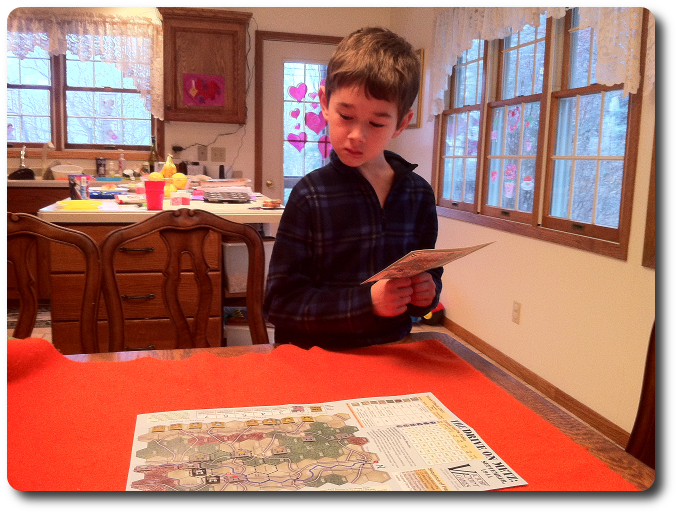
My little geeks sets up the game map like a general
The Parent Geeks were again, sadly, mixed. For those Parent Geeks who enjoyed Trenches of Valor, they found The Drive on Metz to feel slightly less than a wargame. The game kept them interested and they enjoyed playing it with their Child Geeks, but they never really felt like they were doing anything other than jockeying for position. If you lost ground, you didn’t need to worry about it because you simply just reclaimed it the next round. The constant back and forth just didn’t appeal to them. In startling contrast, the Parent Geeks who didn’t care for Trenches of Valor loved The Drive on Metz. According to one Parent Geek, “this is a wargame that makes me feel like I am commanding huge forces, but I never have to lose a single soldier or my mind!” Very true! In the end, the Parent Geeks couldn’t decide to fully approve or reject the game. They thought is was “good” to “great”, and never really “loved it”, but most certainly never “hated it”. What a silly group.
The Gamer Geeks enjoyed The Drive on Metz but didn’t think it really qualified as a full-blown wargame. They did acknowledge that it was fast, fun, and easy to learn. They thought it was an excellent game to be played by two people when time was available, a great way to introduce wargaming, and found the entire game playing experience ripe with opportunities to fine tune strategy and tactics. A few of the Gamer Geeks didn’t like the fact that units were never removed and the outcome of a battle was based on a roll of a die versus unit strength, but one Gamer Geek very much approved of it. To quote him, “this is a game that allows you to make mistakes, learn from them, and have enough time to try something new.” Brilliant and I couldn’t have said it better myself. The Gamer Geeks happily endorsed The Drive on Metz and were once again impressed with the level of detail and fun that was packed into such a small game.
The Drive on Metz is a wonderful introduction to wargames. Easy to follow rules and a small number of pieces to command make it a fantastic way to bring the wargame genre to the gaming table without intimidating new players. But this game is no walk in the park, despite being easy to learn. It challenged our most skilled of players, but the path to victory is clear to all from the start. Staying on that path is the trick.
For the player commanding the United States forces, the game is something of an uphill battle, figuratively speaking. The commander of the German forces will quickly earn victory points and will continue to do so until the United States forces push across the river. This means the United States must be very aggressive and be highly focused on the objectives that will earn as many victory points as possible. In contrast, for the player commanding the German forces, points are awarded early and easily. However, that starts to change after a few rounds. The key to success for the German commander is one part containment and one part movement, keeping the United States forces from advancing while advancing their own units off the map to get victory points. If they can do both and hold off the United States forces for the duration of the game, victory is sure to be won.
As you can see, neither side has it easy. Both players are given advantages as well as disadvantages right from the start. Despite the victory points being awarded to the German commander early on and in abundance, the game never feels like it is off-balance. That means a lot to most players and to me. I very much enjoyed The Drive on Metz and would recommend it to anyone who was looking to introduce wargames to others or just wanted an enjoyable light wargame to play with a friend.
This game was given to Father Geek as a review copy. Father Geek was not paid, bribed, wined, dined, or threatened in vain hopes of influencing this review. Such is the statuesque and legendary integrity of Father Geek.




Is this a game you and Will and PEte would like to play — or they on their own. I remember you playing Risk as little kids!
Yeah…my Mom reads my web site…
No, Mom, this is not a game I can play with my two other brothers as it is a two player game. And thank you so much for bringing up painful memories of playing Risk as a kid. There was a good week where my brothers and I didn’t talk to each other due to an unfortunate turn of events in Australia. It still haunts me….so much blood and loss of plastic….